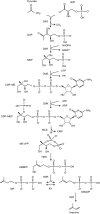Isoprene emission from plants: why and how
- PMID: 17921528
- PMCID: PMC2701830
- DOI: 10.1093/aob/mcm240
Isoprene emission from plants: why and how
Abstract
Background: Some, but not all, plants emit isoprene. Emission of the related monoterpenes is more universal among plants, but the amount of isoprene emitted from plants dominates the biosphere-atmosphere hydrocarbon exchange.
Scope: The emission of isoprene from plants affects atmospheric chemistry. Isoprene reacts very rapidly with hydroxyl radicals in the atmosphere making hydroperoxides that can enhance ozone formation. Aerosol formation in the atmosphere may also be influenced by biogenic isoprene. Plants that emit isoprene are better able to tolerate sunlight-induced rapid heating of leaves (heat flecks). They also tolerate ozone and other reactive oxygen species better than non-emitting plants. Expression of the isoprene synthase gene can account for control of isoprene emission capacity as leaves expand. The emission capacity of fully expanded leaves varies through the season but the biochemical control of capacity of mature leaves appears to be at several different points in isoprene metabolism.
Conclusions: The capacity for isoprene emission evolved many times in plants, probably as a mechanism for coping with heat flecks. It also confers tolerance of reactive oxygen species. It is an example of isoprenoids enhancing membrane function, although the mechanism is likely to be different from that of sterols. Understanding the regulation of isoprene emission is advancing rapidly now that the pathway that provides the substrate is known.
Figures





Similar articles
-
Isoprene synthesis by plants and animals.Endeavour. 1996;20(2):74-8. doi: 10.1016/0160-9327(96)10014-4. Endeavour. 1996. PMID: 8690002 Review.
-
Regulation of isoprene emission in Populus trichocarpa leaves subjected to changing growth temperature.Plant Cell Environ. 2008 Feb;31(2):258-67. doi: 10.1111/j.1365-3040.2007.01758.x. Epub 2007 Dec 7. Plant Cell Environ. 2008. PMID: 17996012
-
Gene expression analysis of disabled and re-induced isoprene emission by the tropical tree Ficus septica before and after cold ambient temperature exposure.Tree Physiol. 2016 Jul;36(7):873-82. doi: 10.1093/treephys/tpw032. Epub 2016 Apr 28. Tree Physiol. 2016. PMID: 27126228
-
Stabilization of thylakoid membranes in isoprene-emitting plants reduces formation of reactive oxygen species.Plant Signal Behav. 2012 Jan;7(1):139-41. doi: 10.4161/psb.7.1.18521. Plant Signal Behav. 2012. PMID: 22301981 Free PMC article.
-
The future of isoprene emission from leaves, canopies and landscapes.Plant Cell Environ. 2014 Aug;37(8):1727-40. doi: 10.1111/pce.12289. Epub 2014 Mar 6. Plant Cell Environ. 2014. PMID: 24471530 Review.
Cited by
-
Heat Waves Change Plant Carbon Allocation Among Primary and Secondary Metabolism Altering CO2 Assimilation, Respiration, and VOC Emissions.Front Plant Sci. 2020 Aug 14;11:1242. doi: 10.3389/fpls.2020.01242. eCollection 2020. Front Plant Sci. 2020. PMID: 32922421 Free PMC article.
-
Responses of isoprene emission and photochemical efficiency to severe drought combined with prolonged hot weather in hybrid Populus.J Exp Bot. 2020 Dec 31;71(22):7364-7381. doi: 10.1093/jxb/eraa415. J Exp Bot. 2020. PMID: 32996573 Free PMC article.
-
Cyanobacteria as cell factories to produce plant secondary metabolites.Front Bioeng Biotechnol. 2015 Apr 28;3:57. doi: 10.3389/fbioe.2015.00057. eCollection 2015. Front Bioeng Biotechnol. 2015. PMID: 25973419 Free PMC article. Review.
-
Some like it hot, some like it warm: phenotyping to explore thermotolerance diversity.Plant Sci. 2012 Oct;195:10-23. doi: 10.1016/j.plantsci.2012.06.004. Epub 2012 Jun 26. Plant Sci. 2012. PMID: 22920995 Free PMC article. Review.
-
Flux of the biogenic volatiles isoprene and dimethyl sulfide from an oligotrophic lake.Sci Rep. 2018 Jan 12;8(1):630. doi: 10.1038/s41598-017-18923-5. Sci Rep. 2018. PMID: 29330538 Free PMC article.
References
-
- Anderson SL, Teakle GR, Martino-Catt SJ, Kay SA. Circadian clock- and phytochrome-regulated transcription is conferred by a 78 bp cis-acting domain of the Arabidopsis CAB2 promoter. The Plant Journal. 1994;6:457–470. - PubMed
-
- Behnke K, Ehlting B, Teuber M, Bauerfeind M, Louis S, Hänsch R, et al. Transgenic, non-isoprene emitting poplars don't like it hot. The Plant Journal. 2007;56:485–499. - PubMed
Publication types
MeSH terms
Substances
LinkOut - more resources
Full Text Sources
Other Literature Sources
Molecular Biology Databases

